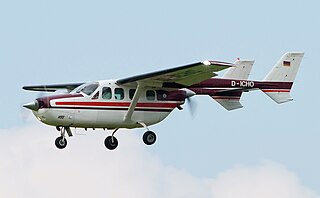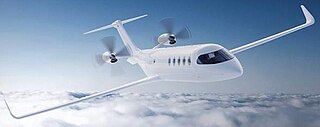
The Cessna 172 Skyhawk is an American four-seat, single-engine, high wing, fixed-wing aircraft made by the Cessna Aircraft Company. First flown in 1955, more 172s have been built than any other aircraft. It was developed from the 1948 Cessna 170 but with tricycle landing gear rather than conventional landing gear. The Skyhawk name was originally used for a trim package, but was later applied to all standard-production 172 aircraft, while some upgraded versions were marketed as the Cutlass, Powermatic, and Hawk XP. The aircraft was also produced under license in France by Reims Aviation, which marketed upgraded versions as the Reims Rocket.

A regional airliner or a feeder liner is a small airliner that is designed to fly up to 100 passengers on short-haul flights, usually feeding larger carriers' airline hubs from small markets. This class of airliners is typically flown by the regional airlines that are either contracted by or subsidiaries of the larger airlines. Regional airliners are used for short trips between smaller towns or from a larger city to a smaller city. Feeder liner, commuter, and local service are all alternative terms for the same class of flight operations.

The Cessna 208 Caravan is a utility aircraft produced by Cessna. The project was commenced on November 20, 1981, and the prototype first flew on December 9, 1982. The production model was certified by the FAA in October 1984 and its Cargomaster freighter variant was developed for FedEx. The 4 ft (1.2 m) longer 208B Super Cargomaster first flew in 1986 and was developed into the passenger 208B Grand Caravan.

Harbour Air Seaplanes is a scheduled floatplane service, tour and charter airline based in Richmond, British Columbia, Canada. The predominantly seaplane airline specializes in routes between Vancouver, Nanaimo, Victoria, Sechelt, Comox, Whistler and the Gulf Islands, primarily with de Havilland Canada floatplanes. Harbour Air operates de Havilland Beavers, Otters and Twin Otters.

The Cessna Skymaster is an American twin-engine civil utility aircraft built in a push-pull configuration. Its engines are mounted in the nose and rear of its pod-style fuselage. Twin booms extend aft of the wings to the vertical stabilizers, with the rear engine between them. The horizontal stabilizer is aft of the pusher propeller, mounted between and connecting the two booms. The combined tractor and pusher engines produce centerline thrust and a unique sound. The Cessna O-2 Skymaster is a military version of the Cessna Model 337 Super Skymaster.

The PAC P-750 XSTOL, is a utility aircraft of conventional all-metal low-wing monoplane design, with fixed tricycle undercarriage. Combining the engine and wings of the PAC Cresco with a new larger fuselage and modified tail, all versions to date have been powered by a 750 hp (560 kW) Pratt & Whitney Canada PT6 turboprop. It is designed and manufactured in Hamilton, New Zealand, by Pacific Aerospace Limited.

The aircraft diesel engine or aero diesel is a diesel-powered aircraft engine. They were used in airships and tried in aircraft in the late 1920s and 1930s, but were never widely adopted until recently. Their main advantages are their excellent specific fuel consumption, the reduced flammability and somewhat higher density of their fuel, but these have been outweighed by a combination of inherent disadvantages compared to gasoline-fueled or turboprop engines. The ever-rising cost of avgas and doubts about its future availability have spurred a resurgence in aircraft diesel engine production in the early 2010s.

An electric aircraft is an aircraft powered by electricity. Electric aircraft are seen as a way to reduce the environmental effects of aviation, providing zero emissions and quieter flights. Electricity may be supplied by a variety of methods, the most common being batteries. Most have electric motors driving propellers or turbines.
The Dornier Do 14 was a prototype seaplane, developed by Dornier Flugzeugwerke with backing from the Luftwaffe for experimental propulsion studies. The aircraft was similar to the Dornier Do 12. Only one Dornier Do 14 was constructed for testing, the aircraft registered as "D-AGON", after test flights during 1936, the aircraft engines were subsequently dismantled in 1937. The prototype aircraft was finally scrapped in 1939.

The RED A03 is a V12 four-stroke aircraft diesel engine designed and built by RED Aircraft GmbH of Adenau, Germany.

The NASA X-57 Maxwell was an experimental aircraft developed by NASA, intended to demonstrate technology to reduce fuel use, emissions, and noise. The first flight of the X-57 was scheduled to take place in 2023, but the program was cancelled due to problems with the propulsion system.

The Lilium Jet is a prototype German electric vertical take-off and landing (eVTOL) electrically powered airplane designed by Lilium GmbH. A seven-seat production version is planned.

The Eviation Alice is an electric aircraft designed to accommodate nine passengers and two crew members. First developed in Israel, its construction incorporates 95% composite material, is powered by two electric motors, and has a T-tail. The prototype first flew on 27 September 2022.

Wright Electric is an American startup company developing an electric airliner.
The Airbus/Rolls-Royce/Siemens E-Fan X was a hybrid electric aircraft demonstrator being developed by a partnership of Airbus, Rolls-Royce plc and Siemens. Announced on 28 November 2017, it followed previous electric flight demonstrators towards sustainable transport for the European Commission’s Flightpath 2050 Vision. A BAe 146 flying testbed was to have one of its four Lycoming ALF502 turbofans replaced by a Siemens 2 MW (2,700 hp) electric motor, adapted by Rolls-Royce and powered by its AE2100 turboshaft, controlled and integrated by Airbus with a 2 t (4,400 lb) battery. In April 2020, the programme was cancelled during the COVID-19 pandemic.

The VoltAero Cassio is a family of hybrid electric aircraft being developed by startup company VoltAero. The company plans to produce three configurations of the Cassio aircraft: the four-place Cassio 330, the six-place Cassio 480, and the ten-place Cassio 600.
A hybrid electric aircraft is an aircraft with a hybrid electric powertrain. As the energy density of lithium-ion batteries is much lower than aviation fuel, a hybrid electric powertrain may effectively increase flight range compared to pure electric aircraft. By May 2018, there were over 30 hybrid electric aircraft projects, and short-haul hybrid-electric airliners were envisioned from 2032.
The Ampaire Electric EEL is a hybrid electric aircraft developed by U.S. startup Ampaire, established in Hawthorne, California. The forward piston engine of a Cessna 337 Skymaster is replaced by an electric motor powered by a battery, in a parallel hybrid configuration. The demonstrator first flew on 6 June 2019.
The Safran EngineUS is a family of electric motors for aircraft propulsion developed by Safran, outputting up to 1,000 kW (1,300 hp).

The Electra EL-2 Goldfinch is a technology demonstrator developed by U.S. startup Electra.aero. The EL-2 is a hybrid electric aircraft with distributed propulsion for short takeoff and landing (STOL).















